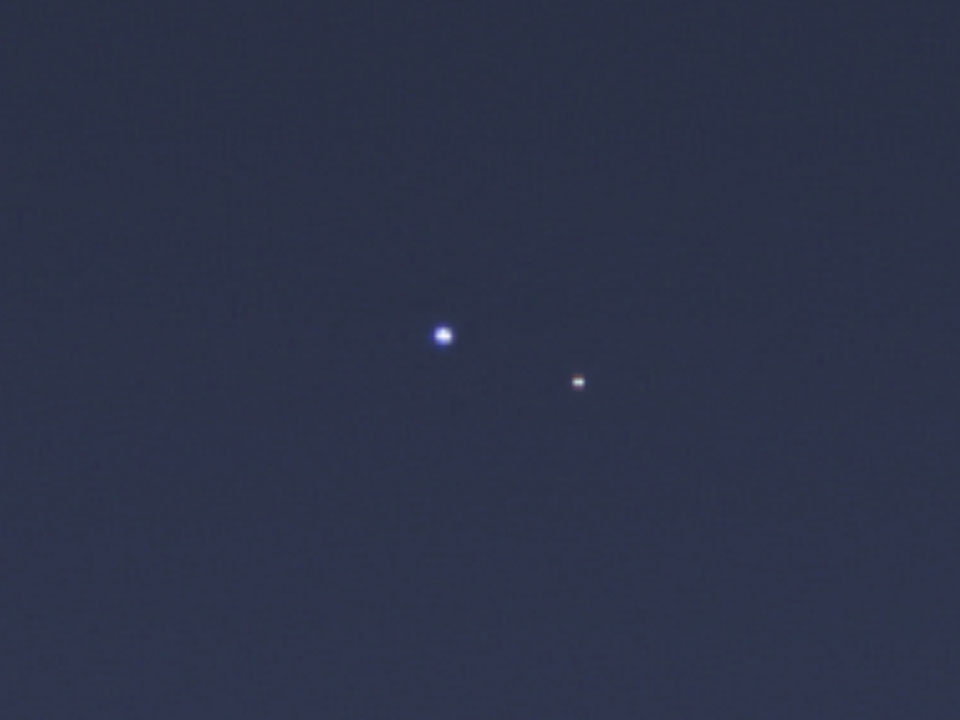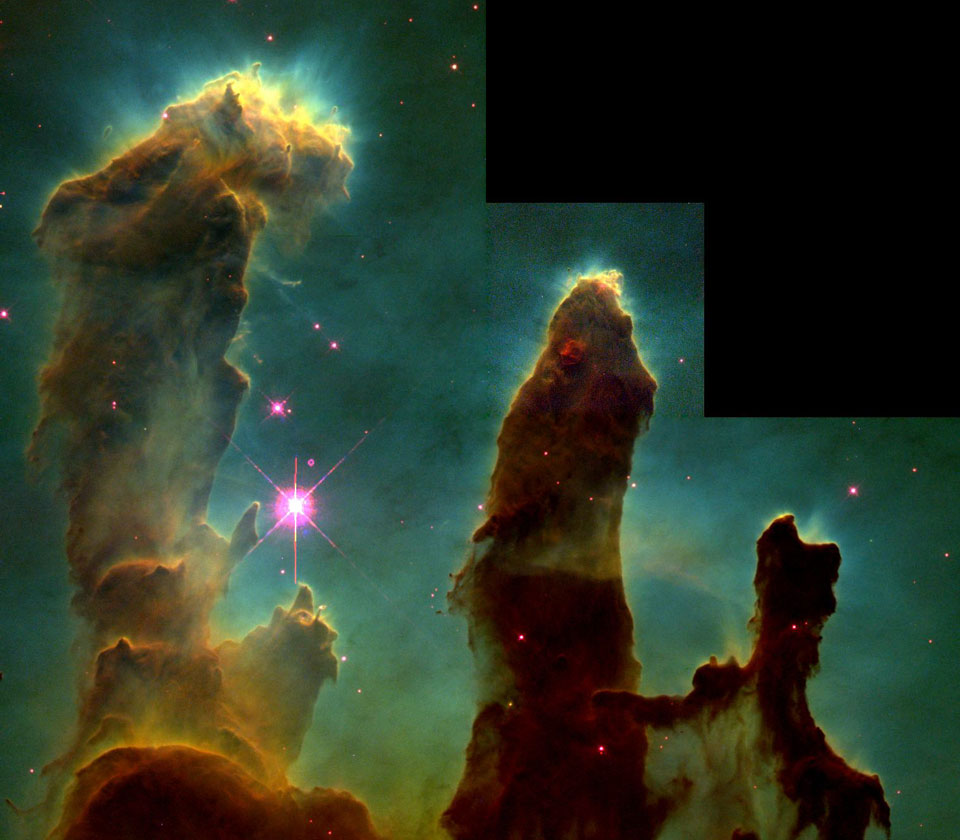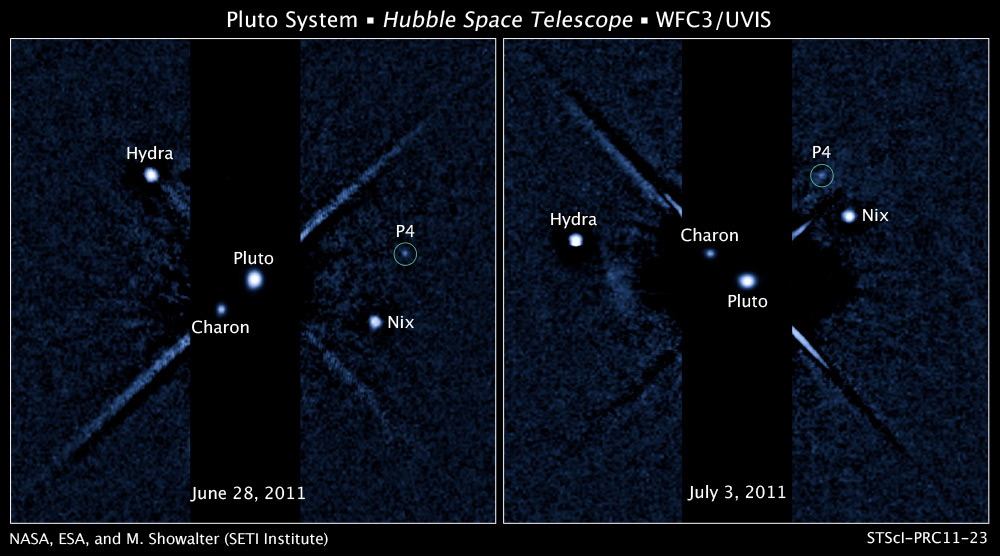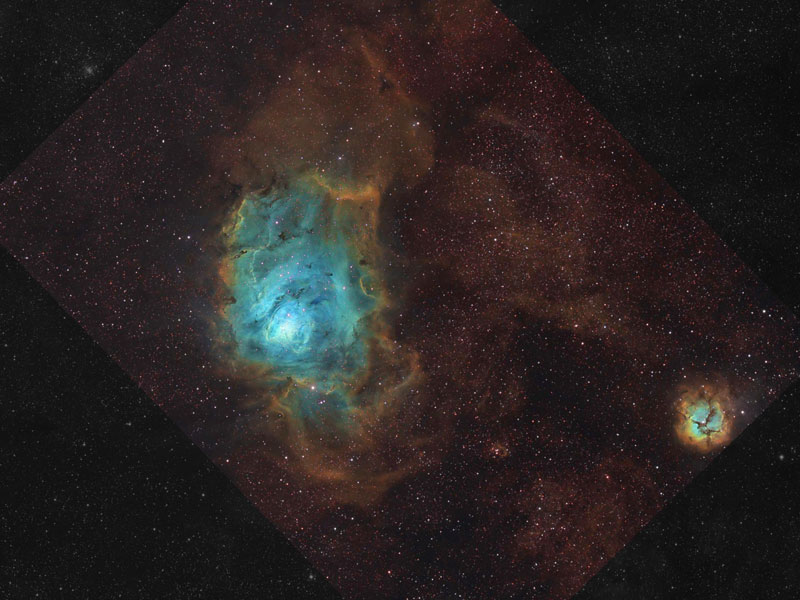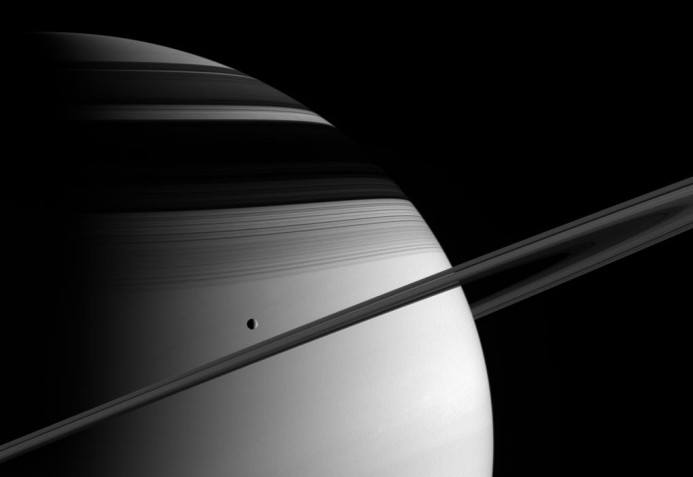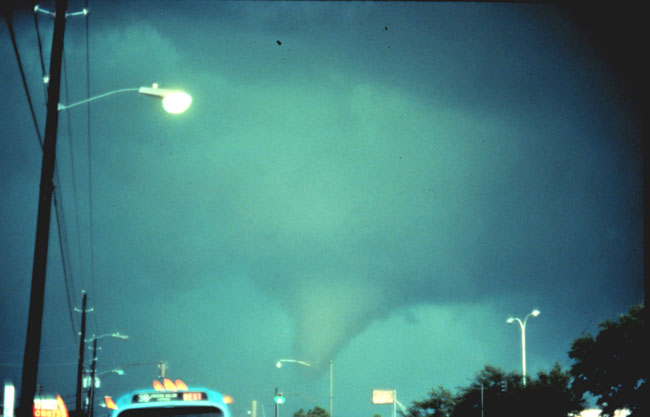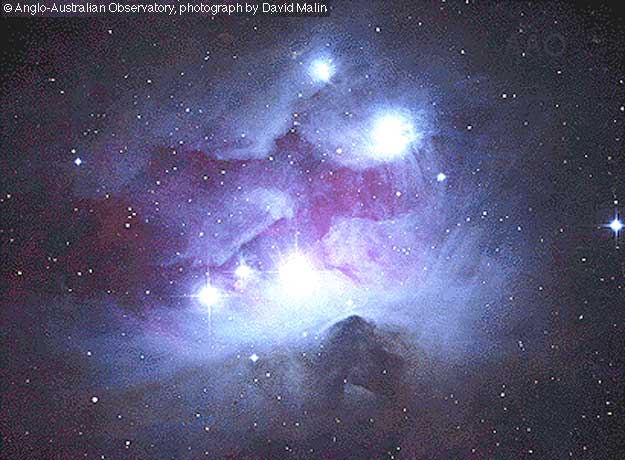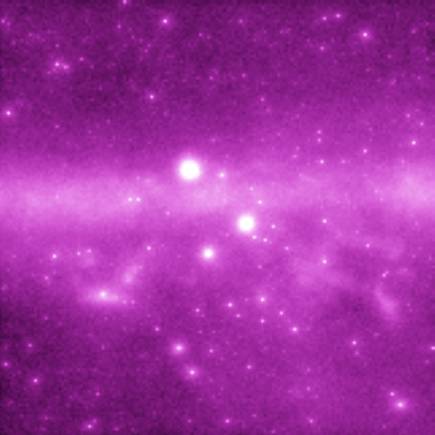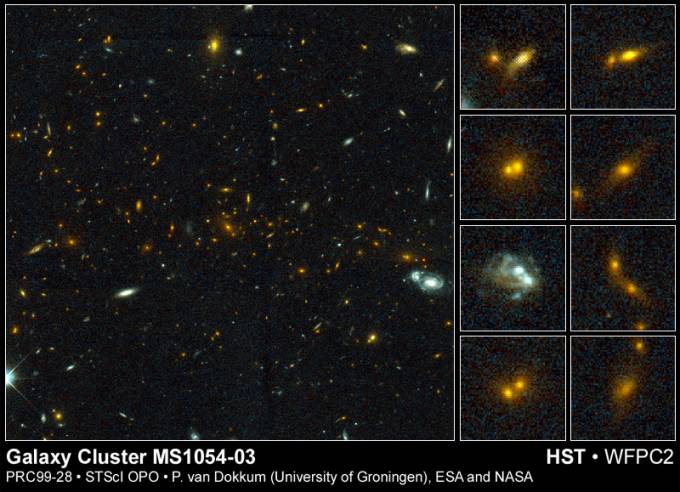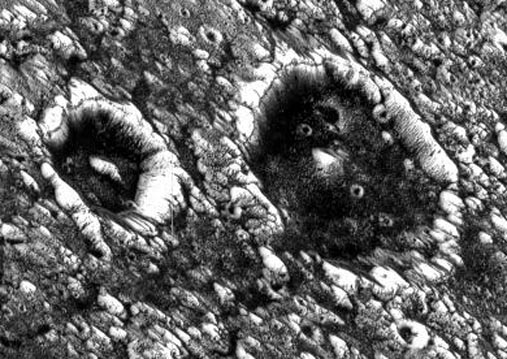| << Previous | Index | Next >> |
2015
Click to play embedded YouTube video.
Video Credit: NASA, DOE, International Fermi LAT Collaboration
2014 Yes, but have you ever seen aurora from a cave? To capture this fascinating juxtaposition between below and above, astrophotographer Bjargmundsson spent much of a night alone in the kilometer-long Raufarhólshellir lava cave in Iceland during late March. There, he took separate images of three parts of the cave using a strobe for illumination. He also took a deep image of the sky to capture faint aurora, and digitally combined the four images later. The 4600-year old lava tube has several skylights under which stone rubble and snow have accumulated. Oh -- the person standing on each mound -- it's the artist.
2013 You are here. Everyone you've ever known is here. Every human who has ever lived -- is here. Pictured above is the Earth-Moon system as captured by the Cassini mission orbiting Saturn in the outer Solar System. Earth is the brighter and bluer of the two spots near the center, while the Moon is visible to its lower right. Images of Earth from Saturn were taken on Friday. Quickly released unprocessed images were released Saturday showing several streaks that are not stars but rather cosmic rays that struck the digital camera while it was taking the image. The above processed image was released earlier today. At nearly the same time, many humans on Earth were snapping their own pictures of Saturn.
2012 It was one of the most famous images of the 1990s. This image, taken with the Hubble Space Telescope in 1995, shows evaporating gaseous globules (EGGs) emerging from pillars of molecular hydrogen gas and dust. The giant pillars are light years in length and are so dense that interior gas contracts gravitationally to form stars. At each pillars' end, the intense radiation of bright young stars causes low density material to boil away, leaving stellar nurseries of dense EGGs exposed. The Eagle Nebula, associated with the open star cluster M16, lies about 7000 light years away. The pillars of creation were imaged again in 2007 by the orbiting Spitzer Space Telescope in infrared light, leading to the conjecture that the pillars may already have been destroyed by a local supernova, but light from that event has yet to reach the Earth.
2011 Nix and Hydra were first introduced to human eyes in Hubble Space Telescope images from May 2005, as Pluto's second and third known moons. Now Hubble images have revealed a fourth satellite for the icy, dwarf planet. Provisionally designated P4, it completes an orbit of Pluto in about 31 days. Presently Pluto's smallest and dimmest known moon, P4 is estimated to be 13 to 34 kilometers across. The newly discovered satellite was first spotted in Hubble observations from June 28, and later confirmed in a follow-up on July 3 and July 18. These two panels are composites of both the short and long exposures that include brighter Pluto itself along with Pluto's largest moon Charon. Camera noise and image artifacts also show up in the long exposure segments. The Hubble observations were made while searching for faint rings around the distant world in support of NASA's New Horizons mission, set to fly by the Pluto system in 2015.
2010 Frederic Church (1826-1900), American landscape painter of the Hudson River School, painted what he saw in nature. And on July 20th, 1860, he saw a spectacular string of fireball meteors cross the Catskill evening sky, an extremely rare Earth-grazing meteor procession. From New York City, poet Walt Whitman (1819-1892) also wrote of the "... strange huge meteor procession, dazzling and clear, shooting over our heads" in his poem Year of Meteors (1859-60). But the inspiration for Whitman's words was forgotten. His astronomical reference became a mystery, the subject of scholarly debate until Texas State University physicists Donald Olson and Russell Doescher, English professor Marilynn Olson, and Honors Program student Ava Pope, located reports documenting the date and timing of the spectacular meteor procession. The breakthrough was spotting the connection with Church's relatively little-known painting. Fittingly, the forensic astronomy team's work was just published, on the 150th anniversary of the cosmic event that inspired both poet and painter.
2009 Stars are battling gas and dust in the Lagoon Nebula but the photographers are winning. Also known as M8, this photogenic nebula is visible even without binoculars towards the constellation of Sagittarius. The energetic processes of star formation create not only the colors but the chaos. The red-glowing gas, shown on the above left in re-assigned colors, results from high-energy starlight striking interstellar hydrogen gas. The Trifid nebula is visible on the far right. The dark dust filaments that lace M8 were created in the atmospheres of cool giant stars and in the debris from supernovae explosions. The light from M8 we see today left about 5,000 years ago. Light takes about 50 years to cross this section of M8.
2008
Credit: Matt Harding & Melissa Nixon
2007 An example of solar-powered flight, NASA's Helios aircraft flew almost one hundred years after the Wright brothers' historic flight on December 17, 1903. Pictured here at 10,000 feet in in skies northwest of Kauai, Hawaii in August 2001, the remotely piloted Helios is traveling at about 25 miles per hour. Essentially an ultralight flying wing with 14 electric motors, the aircraft was built by AeroVironment Inc. Covered with solar cells, Helios' impressive 247 foot wide wing exceeded the wing span and even overall length of a Boeing 747 jet airliner. Climbing during daylight hours, the prototype aircraft ultimately reached an altitude just short of 100,000 feet, breaking records for non-rocket powered flight. Helios was intended as a technology demonstrator, but in the extremely thin air 100,000 feet above Earth's surface, the flight of Helios also approached conditions for winged flight in the atmosphere of Mars.
2006
[imghover6=http://apod.nasa.gov/apod/image/0607/mira_xray_cxc.jpg]http://apod.nasa.gov/apod/image/0607/mira_ill4_cxc.jpg[/imghover6]Credit: X-ray Image: M. Karovska (Harvard-Smithsonian CfA) et al., CXC / NASA; Illustration: M.Weiss (CXC)
2005 Seen from ice moon Tethys, rings and shadows would play across fantastic views of the Saturnian system. Haven't dropped in on Tethys lately? Then this gorgeous ringscape from the Cassini spacecraft will have to do for now. Caught in sunlight just below and left of picture center, Tethys itself is about 1,000 kilometers in diameter and orbits not quite five saturn-radii from the center of the gas giant planet. At that distance (around 300,000 kilometers) it is well outside Saturn's main bright rings, but Tethys is still one of five major moons that find themselves within the boundaries of the faint and tenuous outer E ring. Discovered in the 1980s, two very small moons Telesto and Calypso are locked in stable locations along Tethys' orbit. Telesto precedes and Calypso follows Tethys as the trio circles Saturn.
2004 In this alluring time exposure, star trails arc across the night sky above Monterey Bay and the lights of Santa Cruz, California, USA. But since the exposure began around 3:01am PDT on July 15 it also records the long trail of a Delta II rocket lofting NASA's Aura spacecraft into Earth orbit. Watching from a vantage point about 200 miles north of the Vandenberg Air Force Base launch site, photographer Rick Baldridge reports that the trail represents the first five minutes of the rocket's powered flight with the ignition of additional solid fuel strap-on motors visible after liftoff, near the beginning of the track. The rocket trail ends at first stage shutdown. Seen under the rocket's path, the two brightest star trails mark the alpha and beta stars of the high-flying constellation Grus. The Aura spacecraft's goal is a comprehensive study of planet Earth's nurturing atmosphere.
2003 Large storms on Earth can spawn unusual, small, violent clouds known as tornadoes. Tornado clouds swirl as fast as hundreds of kilometers per hour and, when they touch down, can destroy nearly everything in their long, narrow path. Many tornadoes last only a few minutes, but the largest and most dangerous can endure for hours. The above image, although somewhat unfocussed, appears to show a dropping funnel cloud interacting with a light pole. If so, and this interpretation is controversial, this photograph would be one of the few indicating a clear distance to the funnel cloud. The pictured tornado occurred in 1981 in Dallas, Texas, USA. Tornadoes occur all over Earth but are most commonly found over parts of central North America during spring. Much about tornadoes remains under study, including predicting when they will occur.
2002 Did you ever have a day when it felt like a dark cloud was following you around? For the open cluster of stars NGC 6520, every day is like this. On the left of the above picture are many of NGC 6520's bright blue stars. They formed only millions of years ago - much more recently than our ancient Sun which formed billions of years ago. On the right is an absorption nebula, molecular cloud Barnard 86, from which the stars of NGC 6520 surely formed. This nebula contains much opaque dust that blocks light from the many stars that would have been visible in the background. Surrounding NGC 6520 is part of the tremendously dense starscape in the bulge of our Milky Way Galaxy, the extended halo of stars that surrounds the center of our Galaxy. NGC 6520 spans about 10 light years and lies about 5500 light years away toward the direction of Sagittarius.
2001 The Orion Nebula is visible to the unaided eye as a fuzzy patch near the famous belt of three stars in the Orion. The above picture captures a part of the Orion Nebula that primarily reflects light from bright Orion stars. This reflection nebula appears blue because the blue light from the neighboring stars scatters more efficiently from nebula gas than does red light. The dark lanes are composed of mostly interstellar dust - fine needle-shaped carbon grains.
2000 What shines in the gamma-ray sky? This simulated image models the intensities of gamma rays with over 40 million times the energy of visible light, and represents how the sky might appear to the Gamma-ray Large Area Space Telescope (GLAST) after its first year in orbit. Familiar steady stars are absent from the dramatic 80x80 degree field which looks directly away from the center of the Galaxy. Instead, the Geminga and Crab pulsars - bizarre, spinning stellar corpses known to be neutron stars - are the two brightest gamma-ray sources. These and other gamma-ray bright objects in the field, monstrous active galaxies and still unknown sources, have been detected by the Energetic Gamma-Ray Experiment Telescope (EGRET) on the orbiting Compton Gamma-Ray Observatory. However, most of the simulated sources are new - extrapolating current ideas and anticipating discoveries resulting from GLAST's improved gamma-ray vision. The central broad band of faint gamma-ray emission is due to high-energy cosmic rays colliding with interstellar gas in the outer spiral arms of the Milky Way, while below is a diffuse energetic glow from prominent molecular clouds in Monoceros, Orion, Auriga, and Taurus. Intended to explore extreme environments in the distant cosmos and planned for launch in 2005, GLAST is under development by NASA, U.S., and international partners.
1999 Hundreds of galaxies appear as faint smudges of light in this Hubble Space Telescope picture of galaxy cluster MS1054-03. Eight billion light-years away, the cluster is among the most distant known clusters of galaxies and is now reported to contain the largest number of colliding galaxies ever found in a cluster. Examples of these truly cosmic collisions are shown in the insets at the right. Disrupted by gravitational effects, the colliding galaxies are thought to merge over a billion years or so to form larger galaxies - a theory of galaxy formation which seems to be borne out by these results. Though galaxy collisions appear to have occurred much more frequently in the distant, early Universe, they are still seen to happen in the nearby, "close-to-present" Universe.
1998 Ganymede has craters within craters within craters. The old surface of the largest moon in the Solar System shows its age by the large amount of these impact features. The above picture released last week shows two old craters with dark floors located in a relatively bright region known as Memphis Facula, a region itself thought created by an ancient collision. The strange dark floors of these craters were themselves created long ago and now house craters of their own. Crater Chrysor, on the left, spans about 6000 meters, about half that of crater Aleyn on the right. The robot spacecraft Galileo took the above photograph during a flyby of this moon of Jupiter in June 1996.
1997 Scroll right to unfold the latest panorama of the surface of Mars. For best viewing, click and hold on the right arrow icon at the bottom of your browser window. This image, released yesterday and dubbed a "presidential panorama" by the Mars Pathfinder team, shows in colorful detail the surroundings of the Sagan Memorial Station. Now look closely at the big rock midway through the scrolling picture. That rock is called Yogi and just to its left is the robot Sojourner Rover taking measurements of it. Other now-famous rocks are also visible including Barnacle Bill and Flat Top. After this picture was taken Sojourner went on to analyze a rock named Scooby Doo. Intermittent communications problems continue to cause occasional delays in downloading data and images from Mars Pathfinder.
1996 The Viking 2 spacecraft was launched on the Road to Utopia in September of 1975 (30 years after Bing, Dotty, and Bob). In August of 1976, after making the second successful Martian landing, Viking 2's lander began recording data used to produce this exquisitely detailed image of the Martian surface in the area of Utopia Planitia (the Plain of Utopia). Visible at the lower right are the protective shroud that covered the lander's soil collector head, ejected after the descent, along with one of the lander's dust covered footpads. Seen near the center are shallow trenches dug by the sampler arm. Mars looks red because its surface is covered with reddish iron oxide dust (rust). This dust, suspended in the thin carbon dioxide atmosphere, also filters the sunlight causing surface views to take on a reddish tinge. The Vikings made the first successful landings on Mars 20 years ago. What does Mars look like today?
1995 This image, showing what looks to be a human face sculpted on the martian surface, was produced using data from NASA's Viking 1 orbiter in 1976. Described in a press release as a "face-like hill" it caused some to offer the sensational speculation that it was an artificial construct built by an intelligent civilization on Mars! As a result, this image was splashed across the covers of many grocery store tabloids at the time. A detailed analysis of multiple images of this feature reveals a natural looking martian hill whose illusory face-like appearance depends on viewing angle and angle of illumination.
| << Previous | Index | Next >> |

